The guitar is an incredibly fun instrument to play, but almost all beginners get frustrated by fingers while playing.
Sore fingers can be frustrating to deal with and if not dealt with properly, those sore fingers can quickly become painful.
In this guide, you will learn everything you need to know about how to prevent and treat finger pain when playing guitar.
Take your time reading it to fully understand the prevention and treatment advice.
There’s a lot of myths and misinformation around how to deal with sore fingers, so this guide will give you all of the facts.
What Causes Finger Pain While Playing Guitar
Before you dive into treatments and remedies, it’s important to understand what causes finger pain.
When the soft and fleshy part of your fingertip is repeatedly pressed against a hard guitar string, it causes micro-trauma in the soft tissue.
In other words, when you repeatedly slam your soft fingers against a hard string, the soft finger wears out.
Playing on a guitar with steel strings will obviously wear your fingers out faster than a guitar with nylon strings. But even nylon strings can be painful for beginners.

If somebody learning guitar keeps playing with sore fingers and doesn’t follow the advice in this guide, the damage to the soft tissue in your fingertips gets worse.
Eventually, the top layers of your fingertips break down and you could end up with blisters or open wounds.
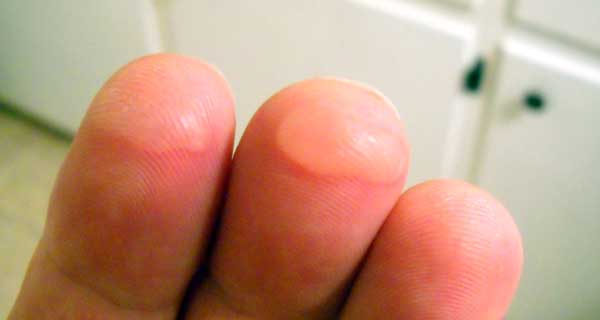
Don’t let your fingers get to the point where you have blisters or open wounds. You’ll have to wait until they completely heal before you start playing again.
The goal of this guide is to prevent your fingers from getting this bad. In some cases, you may be able to completely avoid any finger pain by following the advice in this guide.
Is Your Finger Pain Caused by Injury or Wear?
If you experience any pain when playing guitar, it’s important to work out if that pain is from an injury or from wear and tear.
The sore fingers most beginners experience is a result of wear and tear as your fingers get used to pressing against the guitar strings. This type of sore fingers is not something you should be concerned about.
On the other hand, pain caused by injury is something you do need to worry about.
If you ever experience pain in your hands, wrist, elbow, or shoulder, that’s a sign of a more serious issue.
Bad technique can quickly cause injury and is far more serious than having sore fingers.
You’ve probably heard of carpal tunnel syndrome. It’s a serious issue in your wrist, hand, and fingers caused by repeatedly using bad technique.

This is important to understand because so many guitarists are told to push past any pain to try and develop calluses on your fingertips.
But if your finger pain is partly caused by bad technique, pushing past the pain can quickly turn into a serious issue. You don’t want to have to deal with carpal tunnel syndrome, so take this seriously.
If you ever experience pain or soreness in your wrist, elbow, shoulder, or neck, stop and check your posture and technique. If pain ever spreads to other parts of your body, take it seriously.
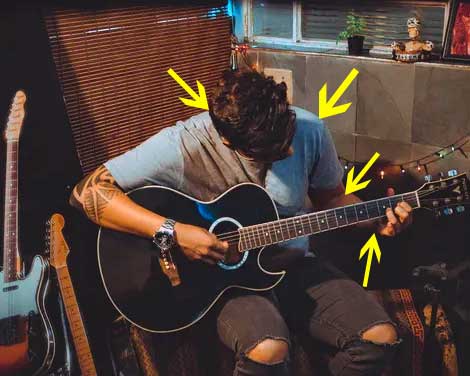
The above photo shows possible areas you might experience pain due to poor posture or technique.
I wouldn’t be surprised if this guitarist experiences some pain in his neck or shoulders due to his hunched posture.
Beginners with big and bulky acoustic guitars tend to experience more pain as they try to lean over the guitar to see their hands (as shown in the above photo).
The key point to remember is that not all pain or soreness is equal. Pain that doesn’t go away or spreads to other parts of your body must be taken seriously.
Beginners and Guitar Finger Pain
If you’re just getting started learning guitar, you’ve probably already experienced some sore fingers or finger pain.
For beginners, there are two main causes for sore fingers: type of guitar strings and finger pressure.
Let’s go through both causes so you can understand how to deal with sore fingers while playing guitar.
Finger Pressure
This is the number one reason why beginners experience finger pain while playing guitar. The amount of pressure you place on the guitar strings plays a massive role in how sore your fingers feel.
It’s well known among guitar teachers that beginners tend to press down way too hard on the strings.
Have you ever watched a video of a pro guitarist effortlessly play incredibly hard parts? Have you noticed how their hands seem to float across the fretboard?

The reason it looks effortless is that they’re playing with a light touch. The guitarist isn’t pressing down hard on the strings.
Advanced guitarists learn to play with the lightest touch possible while keeping the notes ringing out clean.
Your goal as a beginner is to learn how to play with the lightest pressure possible without causing string buzzing.
Try this exercise to get an idea of how much finger pressure you actually need.
Pick up your guitar and fret the 5th fret on the low E string. Pick the note and listen to how it sounds.
Keep your finger on the string and slightly reduce the amount of pressure you apply to it. Pick the string again and listen to how it sounds.
If the note sounds fine, slightly reduce the pressure again and pick the note.
If you keep doing this, eventually you will hear the note start to buzz. When it starts to buzz, slightly increase the pressure until the buzzing stops.
This is the ideal amount of pressure you should apply to the string. Just enough to prevent buzzing, but not any more than this.
What most guitarists find when they do this is that you usually apply far more finger pressure than needed to play a note.
Learning to play with a lighter touch isn’t easy and requires a lot of control. But you can significantly reduce (or sometimes completely eliminate) sore fingers by playing with a lighter touch.
As a guitar teacher, I’ve had a lot of students come to me over the years complaining about finger pain.
When I ask them to play a chord, they press down so hard on the strings I can see their hand, wrist, elbow, and sometimes even shoulder tense up. You can see their fingers turn yellow or white from the amount of pressure they’re applying.
It should be no surprise that as soon as they learned to play with a lighter touch and proper technique, the pain disappeared.
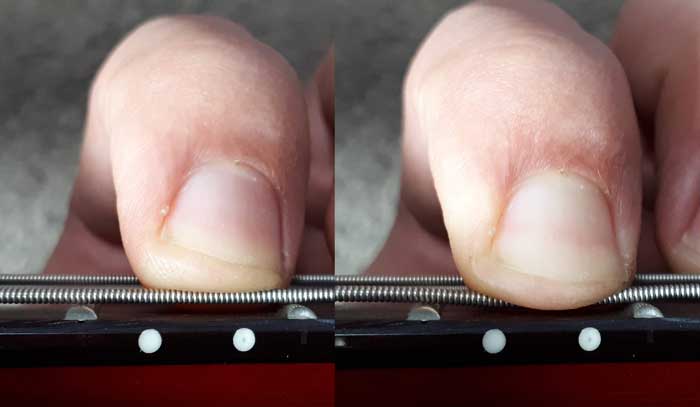
In the above photos, it should be obvious that the photo on the right uses way too much finger pressure.
Key point: too much finger pressure is your number 1 enemy when it comes to finger pain.
Type of Guitar Strings
As covered in my Ultimate Guide to Guitar Strings, guitar strings come in a variety of different materials and thicknesses.
The thicker the strings and the harder the material, the more likely you will experience sore fingers.
Compare the below photos and think about which strings look harder on your fingers:
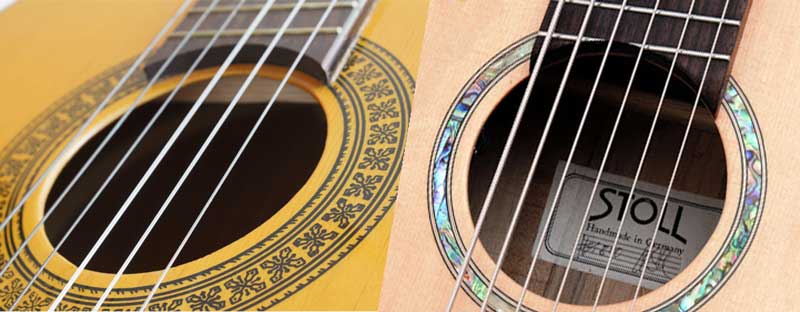
The nylon strings on the left will be far gentler on your fingertips compared to the heavy gauge steel strings on the right.
This isn’t just because steel is harder than nylon, it’s also because of string tension. The higher the string tension, the harder they feel against your fingers.
This is why nylon string acoustics feel easier than steel-string acoustics and why electric guitars generally feel easier than acoustic guitars.
While this doesn’t mean you should start learning on a classical nylon string guitar (find out how each type of guitar feels to learn on here), it does mean you’re less likely to get sore fingers on nylon strings.
But even if you play on a steel-string acoustic guitar (typically the toughest strings to play on), you can avoid or deal with sore fingers by following the advice in this guide.
Key point: the higher the tension of your guitar strings, the more they will contribute to sore fingers.
Find out more about string tension, gauges, and materials here.
Guitar Finger Protection
So far in this guide, you’ve learned about the causes of finger pain. So how can you deal with it?
The chances are, you’ve seen something like this show up in ads or shared on social media:

These are ‘finger protectors’ and are designed to protect your fingertips from finger pain.
Guitar finger protectors are not recommended and can lead to poor technique.
It might seem like a good idea to use these finger protectors in the beginning, but the problem is that you’ll never overcome the problem when you use them.
You can’t expect to toughen up your fingertips if they never actually touch the guitar strings. So you’ll never develop calluses in your fingertips using these things.
Even worse, adding these protectors to your fingertips throws off your technique. You need to adjust your hand and finger position and you end up with bad technique.
You won’t be able to feel whether your fingers are accidentally touching adjacent strings, so you’ll end up with a lot of bad sounding chords or riffs.
Key point: no matter how painful your fingers might be now, finger protectors are not the solution.
Guitar Finger Remedies Reviewed
There are a lot of remedies out there on how to prevent or treat finger pain. Let’s go through the most common suggestions and whether they work or not.
Rubbing Alcohol – Works
The idea behind using rubbing alcohol is that it dries your fingertips out. The more moisture in your fingertips, the softer they will be. So it makes sense that you want dry fingertips.
Use a cotton bud and lightly rub some rubbing alcohol onto your fingertips before playing guitar to try this out.
Don’t use this as a long-term remedy. The idea is to only use it in the beginning to help your fingers toughen up. Once your fingertips start forming calluses, you shouldn’t need to continue to use rubbing alcohol.
Sandpaper – Avoid
The idea here is that the sandpaper toughens up your fingertips but it doesn’t work that way.
Using sandpaper on your fingertips will wear down the surface. That’s not the goal here and will make the issue worse.
To build calluses, you want to stimulate your fingertips to feel pressure, not scratch the surface using sandpaper.
Don’t use sandpaper – it’s a ridiculous remedy that won’t work.
Superglue – Avoid
You’ve probably heard of guitarists using superglue to seal up cut fingers during a live performance.
Applying superglue to your fingertips creates a protective surface and does help prevent the skin on your fingertips from wearing out.
Superglue is a handy last resort, which is why many touring guitarists use it to overcome cut fingers, but it’s not a good approach when you’re trying to develop calluses.
Adding a protective barrier on your fingertips isn’t going to do much to help you develop calluses. While it will help prevent your fingers from wearing down, it will take longer to develop calluses.
Credit Cards – Works
The idea of using a credit card is to help stimulate your finger throughout the day when you’re not playing guitar.
You take the edge of the credit card and press your fingertips against it as if it were a guitar string.
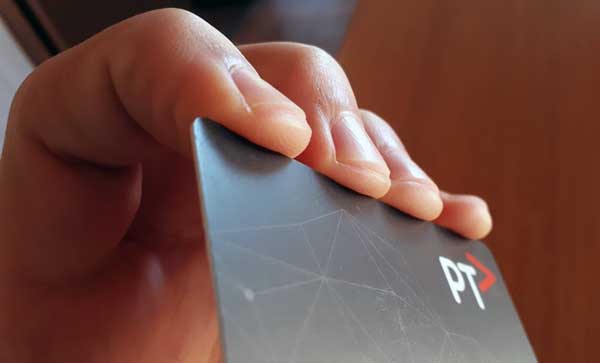
Press your fingers down on the credit card to simulate playing guitar.
Do this throughout the day, but don’t overdo it if your fingers hurt.
If you’re going to be away from your guitar for a few days, using a credit card will help you continue developing calluses.
How to Toughen Fingers for Guitar Playing
Fingertips are softer than guitar strings, so we want our fingertips to toughen up to be able to play without pain.
To understand how to properly toughen up your fingers for playing guitar, it helps to think of how lifting weights at a gym toughens up your muscles.
When you lift heavy weights at the gym, micro-tears form in the muscle fibers. When these micro-tears in your muscles heal, the muscle becomes stronger.

Once the micro-tears heal, you’ll be able to lift heavier weights and your muscles will gradually get stronger.
It’s the same with toughening up your fingertips for playing guitar.
When you play guitar and press down on the strings, it damages the tissue in your fingertips. That’s why your fingers may quickly become sore or hurt.
But once the damage in your fingertips heals, it slightly toughens your fingertips. Once the damage heals, you can play guitar for longer before your fingers feel sore again.
Eventually, your fingertips will be so tough that you don’t experience any soreness at all.
The key detail gym-goers understand is that you need to give your muscles time to heal. If somebody goes slams the same muscles every day in the gym, those micro-tears don’t have time to properly heal.
Giving your muscles rest before working out again is crucial because you want the micro-tears in your muscles to fully heal before tearing them again.
It’s the same with developing calluses in your fingertips. Taking breaks is important to make sure your fingertips have time to properly heal before you slam them again.
When you hear of guitarists with blisters or cut fingers, that’s the result of not giving your fingers enough time to heal before working them out again. It’s just like going to the gym every day and working the exact same muscle over and over. Not a good approach.
Key lesson: toughening up your fingertips is just like growing bigger muscles in the gym. Playing guitar damages your fingertips, but once that damage heals, your fingertips become stronger. Have plenty of breaks to give your fingertips time to properly heal before you work them out again.
If you regularly practice guitar and use appropriate breaks, your fingertips will quickly develop calluses and the soreness will gradually disappear.
Setting Up Your Guitar for Better Playability
Some guitars feel easier on the fingers than others. As explained earlier, string tension and material plays a big role in how hard the strings are on your fingertips.
But the way your guitar is set up also plays an important role in how comfortable it is to play.
If your guitar isn’t set up properly, it may be causing you more pain than it should.
A poorly set up guitar with high action forces you to press down harder and strain yourself.
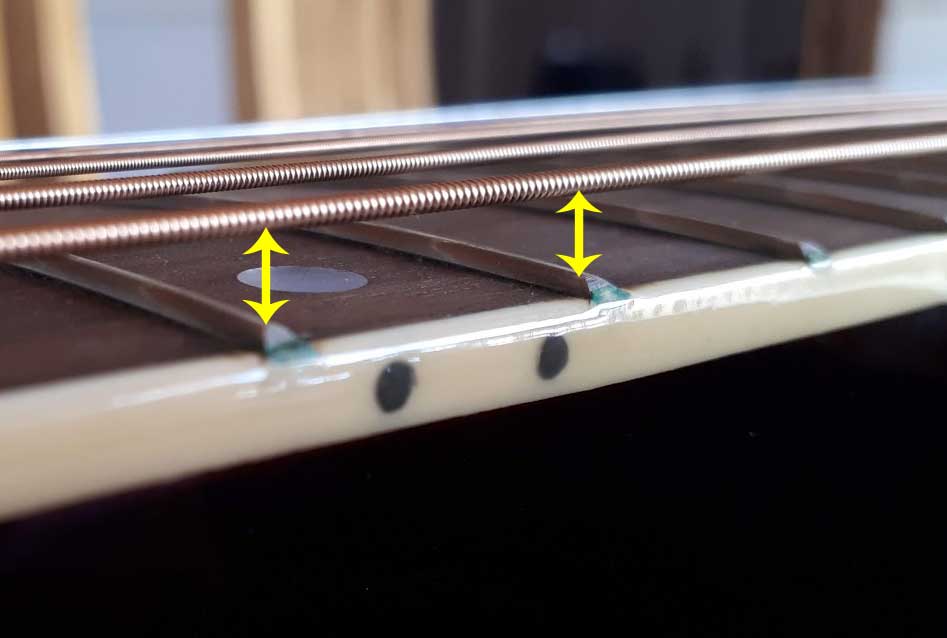
Imagine trying to play some chords on a steel-string acoustic guitar with high action as shown in the above photo.
A lot of guitarists will look at a photo like that and can immediately imagine the pain.
While adjusting your guitar’s action height won’t prevent you from ever getting sore fingers, it may help.
Find out more about action height and how to properly adjust it in this guide.
How to Avoid Sore Fingers When Playing Guitar
Here are the most important tips and advice on how you can avoid sore fingers when playing guitar:
- Use suitable guitar strings
- Use a low action height
- Take regular breaks
- Trim your nails
- Don’t play with wet fingers
Let’s go through the above points and how to get started.
Use suitable guitar strings
Old and corroded guitar strings will wear down your fingertips and can even slice them open.
Brand new guitar strings will often feel slippery-smooth to play and can really help in preventing sore fingers.
Regularly replacing your guitar strings will help you avoid unnecessary pain.
Keeping your guitar strings clean will keep them in good condition, which will make them feel more comfortable under your fingers.
Read through these relevant guides on guitar strings to learn more:
- How often should you change your guitar strings?
- How to clean your guitar strings
- Ultime Guide to Guitar Strings
Use a low action height
The higher the action height on your guitar, the further you need to press the string down to make contact with the frets.
So having a low action height means you don’t need to press as hard to properly sound a note.
Lowering your action height (if possible) may help improve your guitar’s playability and reduce finger pain.
Find out how to adjust action height in this guide.
Take regular breaks
This advice goes against the typical ‘push pain the pain’ advice you might hear floating around, but it works.
As explained earlier, developing calluses is like building muscle. You need to give your fingers time to heal or else they’ll never properly form calluses.
Instead of playing for a marathon 2+ hour session, split your practice time up to give your fingers a chance to rest.
Find out why splitting your practice time up is so important for your progress in this guide.
Trim your nails
When you play a chord, you want your fingertips to press straight down on the string so you don’t accidentally touch adjacent strings.
If you have long nails, it’s hard to properly use your fingertips. Keeping your nails short makes it easier to press down on the strings and will help reduce soreness.
Don’t play with wet fingers
If you’ve just had a long shower or bath or were swimming, your fingers will be saturated with water. Even if they’re not wet to touch, they will be retaining more water than usual.
If you play guitar immediately after taking a shower, your fingers are going to be softer than normal. That means they will wear down faster and get sore faster.
The reason why so many remedies focus on keeping your fingers dry is that dry fingers hold up better against your guitar strings.
Don’t play guitar immediately after your fingers have been wet.
Guitar Finger Pain FAQ
Here are some common questions you might have about finger pain while playing guitar, calluses, and more.
How Long Does it Take for Calluses to Form?
It can take calluses a few weeks to properly form if you follow best practices. It will take a month or longer to form calluses on your fingers if you play the steel-string acoustic guitar due to the higher string tension.
If you give your fingers enough time to heal between practice sessions, they will form faster. If you wear your fingers down too far, instead of calluses forming you’ll end up with cuts or blisters.
When Will My Fingers Stop Hurting From Playing Guitar?
Your fingers will stop hurting from playing guitar once they have toughened up enough to deal with the tension of your guitar strings. If you play nylon string acoustic or electric guitars, this may only take a few weeks. If you play a steel-string acoustic guitar, it may take a month or longer.
Make sure you play with good technique and form, or else the pain won’t go away. As explained earlier in this guide, there is a difference between pain caused by soft fingertips and pain caused by poor technique.
Does Playing Guitar Damage Your Fingers?
Playing guitar does damage your fingers, but only minor damage. Once your fingers heal, they become tougher. Eventually, your fingers will toughen up so much that playing guitar doesn’t cause any damage at all.
Playing guitar is not bad for your fingers. Think of the damage it causes to your fingers in the same way that lifting weights causes damage to muscle tissue. This damage actually helps muscles or fingertips to get tougher.
How Hard Should You Press on Guitar Strings?
You should press on the strings as lightly as possible while pressing enough to avoid string buzzing. Pressing down too hard causes finger pain. Aim to play with a light touch and learn how light you can play without the note buzzing or sounding muted.
Read the advice earlier in this guide to work out how lightly you can press down on the strings.
Should I Stop Playing Guitar If My Fingers Hurt?
If your fingers hurt when playing guitar, take a short break. Try playing again in a few hours or overnight. Give your fingers time to heal and toughen up. Practice regularly to help your fingers toughen up, but use regular breaks to prevent your fingers from wearing down too much.
Read the advice earlier in this guide to avoid finger pain or injuries.
